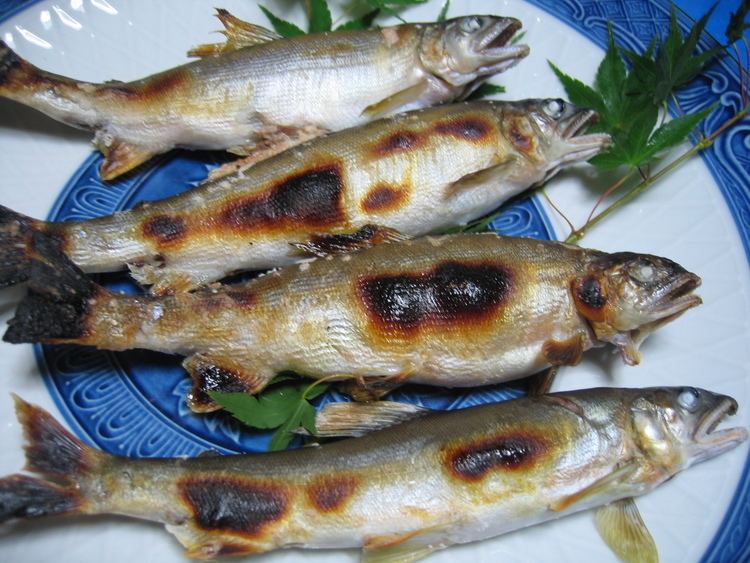Kingdom Animalia Infraclass Teleostei Suborder Osmeroidei Scientific name Plecoglossus altivelis Higher classification Plecoglossus Order Osmeriformes | Superclass Osteichthyes Superorder Protacanthopterygii Superfamily Osmeroidea Phylum Chordata Rank Species Subclass Neopterygii | |
 | ||
Similar Hypomesus nipponensis, Japanese salmon, Salvelinus, Unagi, Rainbow trout | ||
grill ayu fish
The ayu (アユ, 鮎, 年魚, 香魚) or sweetfish, Plecoglossus altivelis, is a species of fish. It is the only species in the genus Plecoglossus and family Plecoglossidae. It is a relative of the smelts and other fish in the order Osmeriformes.
Contents
Native to East Asia, it is distributed in the northwestern Pacific Ocean along the coast of Hokkaidō in Japan southward to the Korean Peninsula, China, Hong Kong and northern Vietnam. It is amphidromous, moving between coastal marine waters and freshwater lakes and rivers. A few landlocked populations also exist in lakes in Japan such as Biwa. It is an introduced species in Taiwan.
The name "sweetfish" was inspired by the sweetness of its flesh. In reference to its typical one-year lifespan, it is also written as 年魚 ("year-fish"). Some individuals live two to three years. The ayu is the prefectural fish of Gunma Prefecture and Gifu Prefecture.
Subspecies
Two to three subspecies are recognized by some authors. Others do not distinguish the subtaxa.
Subspecies include:
Biology
An omnivore, the ayu feeds on algae, crustaceans, insects, sponges, and worms. It feeds on algae that accumulates on the rocks, scraping it off the rocks with their saw-shaped teeth. Adults typically maintain a feeding territory, but the form restricted to lakes is schooling.
Most populations of this species are amphidromous and breed in the lower part of rivers during the spring. After the eggs hatch, the larvae are carried downriver to the sea in the autumn. They stay in coastal regions until the spring where the young fish typically are about 6 cm (2.5 in) long and move back to the rivers. Here they reach 15–30 cm (6–12 in) by the summer. Some die after breeding and only live one year, but others return to the ocean and may spawn up to three times. In Japan, some populations live their entire life in lakes and they typically reach an age of two or three years. During the breeding season the amphidromous and lake-restricted forms may occur together. Ayu are also stocked in reservoirs. The form restricted to lakes, such as Biwa, is considerably smaller than the amphidromous form. Although there are reports of ayu up to 70 cm (2.3 ft) long, a more typical maximum size for the species is about 30 cm (1 ft).
Human uses
Ayu is an edible fish, mostly consumed in East Asia. Its flesh has a distinctive, sweet flavour with "melon and cucumber aromas". It is consequently highly prized as a food fish. The main methods for obtaining ayu are by means of fly fishing, by using a fish trap, and by fishing with a decoy which is known as ayu-no-tomozuri in Japan. The decoy is a living ayu placed on a hook, which swims when immersed into water. It provokes the territorial behavior of other ayu, which assault the "intruder" and get caught.
Japanese fishers also catch it using a traditional method, cormorant fishing (鵜飼 ukai). On the Nagara River where Japanese cormorants (Phalacrocorax capillatus) are used by the fishermen, the fishing season draws visitors from all over the world. The Japanese cormorants, known in Japanese as umi-u (ウミウ, "sea-cormorant"), are domesticated birds trained for this purpose. The bird catches the ayu, stores it in its crop, and delivers it to the fishermen.
Ayu is also fished commercially, and captive juveniles are raised in aquaculture before being released into rivers for sport fishing.
A common method of preparing ayu and other small fish in Japan is to skewer it in such a way so that its body forms a wave, making it look as though it is swimming.
